
Saxifraga is the largest genus in the family Saxifragaceae, containing about 465 species of holarctic perennial plants, known as saxifrages or rockfoils. The Latin word saxifraga means literally "stone-breaker", from Latin saxum + frangere. It is usually thought to indicate a medicinal use for treatment of urinary calculi, rather than breaking rocks apart.

Pimpinella saxifraga, known as burnet-saxifrage, solidstem burnet saxifrage, lesser burnet is a plant species in the family Apiaceae, a native of the British Isles and temperate Europe and Western Asia. It is neither a burnet, which its leaves resemble, nor a saxifrage although it has a similar herbal effect as a diuretic.
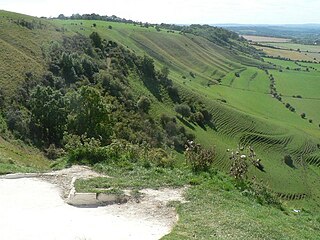
Bratton Downs is a 395.8 hectare biological and geological Site of Special Scientific Interest in Wiltshire, England, near the villages of Bratton and Edington, and about 3 miles (5 km) east of the town of Westbury. It was notified in 1971. The designated area consists mainly of chalk grassland, as well as some ancient woodland, and supports a diverse range of native flora and fauna. It overlays notable geological features—principally landforms created by glaciation in the Pleistocene.
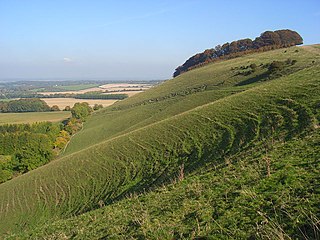
Ham Hill is a hill and area of chalk downland in Wiltshire, England, on the steep banks running alongside the road from the village of Ham to Buttermere, close to the Berkshire border. A biological Site of Special Scientific Interest, notified in 1971, covers 1.5 hectares of the site; this designation is due to the site's species-rich plant and insect communities, which include some rare species. Notable among these is the musk orchid, which has been confirmed at only one other site in Wiltshire.

Saxifraga paniculata is an alpine species of flowering plant in the saxifrage family, with native distribution in the temperate northern hemisphere. Common names include alpine saxifrage, encrusted saxifrage, lifelong saxifrage, lime-encrusted saxifrage, livelong saxifrage, white mountain saxifrage, and silver saxifrage.
Saxifrage or Saxifraga a plant genus.

Depressaria is a moth genus of the superfamily Gelechioidea. It is the type genus of subfamily Depressariinae, which is often – particularly in older treatments – considered a distinct family Depressariidae or included in the Elachistidae, but actually seems to belong in the Oecophoridae.
Mere Beck Meadows, formerly known as Willoughby Hall Meadows, is a Site of Special Scientific Interest in the Teesdale district of County Durham, England. It consists of three hay meadows, situated on the south side of Hury Reservoir, immediately below the Blackton Reservoir dam.

Pimpinella major, common name greater burnet-saxifrage or hollowstem burnet saxifrage, is a herbaceous perennial plant in the genus Pimpinella belonging to the carrot family (Apiaceae).

Depressaria albipunctella is a moth of the family Depressariidae. It is found in most of Europe, as well as in Libya.
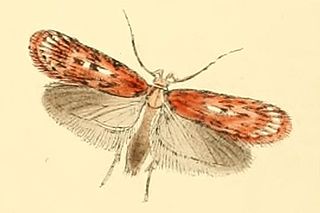
Depressaria pulcherrimella is a moth of the family Depressariidae. It is found in most of Europe, except the Balkan Peninsula.

Epermenia aequidentellus, also known as the carrot lance-wing, is a moth of the family Epermeniidae found in Europe, Madeira and the Canary Islands. It was first described by Ernest Hofmann in 1867, from a specimen found in Vorderer Kaiser, near Kufstein, Austria.

The Ziegenberg is a low ridge between the villages of Benzingerode and Heimburg on the northern edge of the Harz Mountains in central Germany. The ridge is a designated nature reserve. The reserve has an area of 88.4 hectares and has a variety of habitats including mesophytic grassland (Halbtrockenrasen), bushes, pine woods and wet meadows. Its highest points are the eponymous Ziegenberg and the Struvenberg

Epermenia chaerophyllella, also known as the garden lance-wing, is a moth of the family Epermeniidae first described by Johann August Ephraim Goeze in 1783. It is found in all of Europe and Asia Minor.

Phaulernis dentella is a moth of the family Epermeniidae found in Asia and Europe. The moth was first described by Philipp Christoph Zeller in 1839.
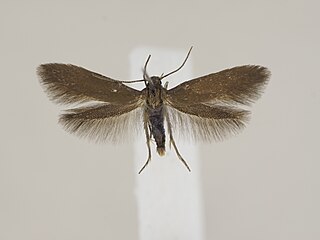
Epermenia profugella, also known as the little lance-wing is a moth of the family Epermeniidae found in northern, central and eastern Europe. The moth was first described by Henry Tibbats Stainton in 1856, from a specimen found in Kemsing, Kent, England.
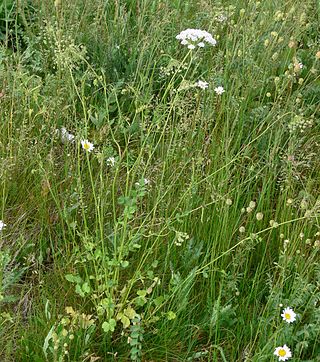
Pimpinella peregrina is a species of biennial herb in the family Apiaceae. They have a self-supporting growth form and simple, broad leaves. Individuals can grow to 0.72 m.















